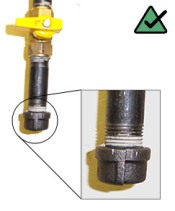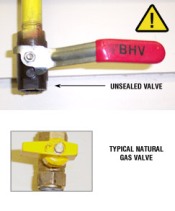Keep an eye out for open gas lines
Sometimes gas lines are not properly closed off
This happens when a natural gas appliance (like a dryer or stove) is replaced with an electric one or removed altogether – and the gas line is not properly capped or plugged.
Open gas lines are dangerous
They can allow natural gas to leak into your home. Although natural gas is non-toxic and non-poisonous, it is highly flammable.
If you smell natural gas you should always call our emergency line at
Spotting an open gas line
Where to look
The most common places to find an open natural gas line are:
- Behind electric appliances like your stove or dryer.
- Outside where a natural gas barbecue might go.
- In the garage where a natural gas heater may have been used.
Examples of Open and Closed Gas Lines
There are many types of natural gas valves. If you have an open gas line, call a qualified gas fitter or heating contractor.
Here are a few examples.
-
 Open Gas Line - Dryer/Stove Connector
Open Gas Line - Dryer/Stove ConnectorThis is a dryer or stove connector that has been left behind. It must be removed and the gas line needs to be capped or plugged.
-
 Closed Gas Line - End cap
Closed Gas Line - End capThis is the end-cap. It is one of two ways to properly seal a natural gas line
-
 Open Gas Line - Natural Gas Valve
Open Gas Line - Natural Gas ValveThis natural gas valve has an open end and it must be capped or plugged. You should never open a natural gas valve.
-
 Closed Gas Line - Threaded Plug
Closed Gas Line - Threaded PlugThis is a dryer or stove connector that has been left behind. It must be removed and the gas line needs to be capped or plugged.